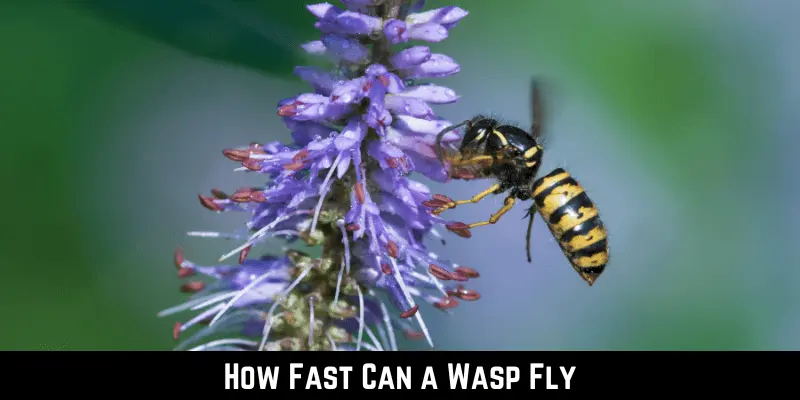Wasps are one of the most prevalent household insects and you may surely see them wandering and flying in your home or yard. Moreover, you can often observe them in your trees, bushes, and under the eaves of your trees. However, do you know; how fast can a wasp fly?
The flight speed of a wasp can vary depending on the type, size, and surroundings. Most wasps can typically fly at a pace of 12 to 15 miles per hour. However, some species that are larger or more agile may be able to fly faster, occasionally reaching speeds of 20 to 25 mph (32 to 40 kph).
Do you want to know more about the flying speed of different wasps? If so, read the below guidelines to know everything about wasps.
Speed of Different Wasp Species
Different wasp species can move at varying speeds based on their size, ability to fly, and the intended function of their movement. Wasps are renowned for their swift movements and agile flight. Here are a few wasp species and an estimate of their maximum flying speeds:
Paper Wasp
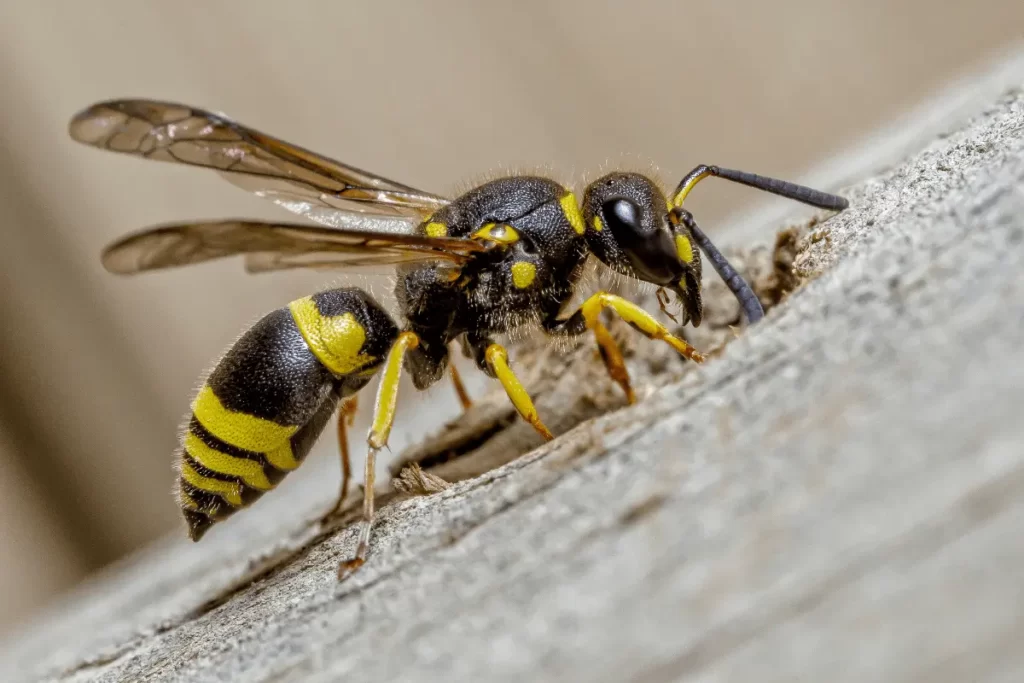
Paper wasps belong to the Hymenoptera family, also including bees, ants, and butterflies. Since they have low-resolution eyesight, like other insects, they must take clues from their surroundings to reach their habitat.
Although paper wasps (Polistes spp.) can fly at different speeds depending on the species, the habitat, and individual differences, they can fly at a pace ranging from 7 to 8 miles per hour. Additionally, paper wasps are not known for their long-distance flights; they fly relatively short distances between their nests, foraging areas, and other resources.
If they feel any threat, you can see them flying even faster. Try to stay away from them if you ever encounter one of these monsters. They can hurt you severely by stinging you. According to the Journal Biology Open, removing a paper wasp sting is easier, but you should avoid it to save yourself.
Yellow Jacket Wasp
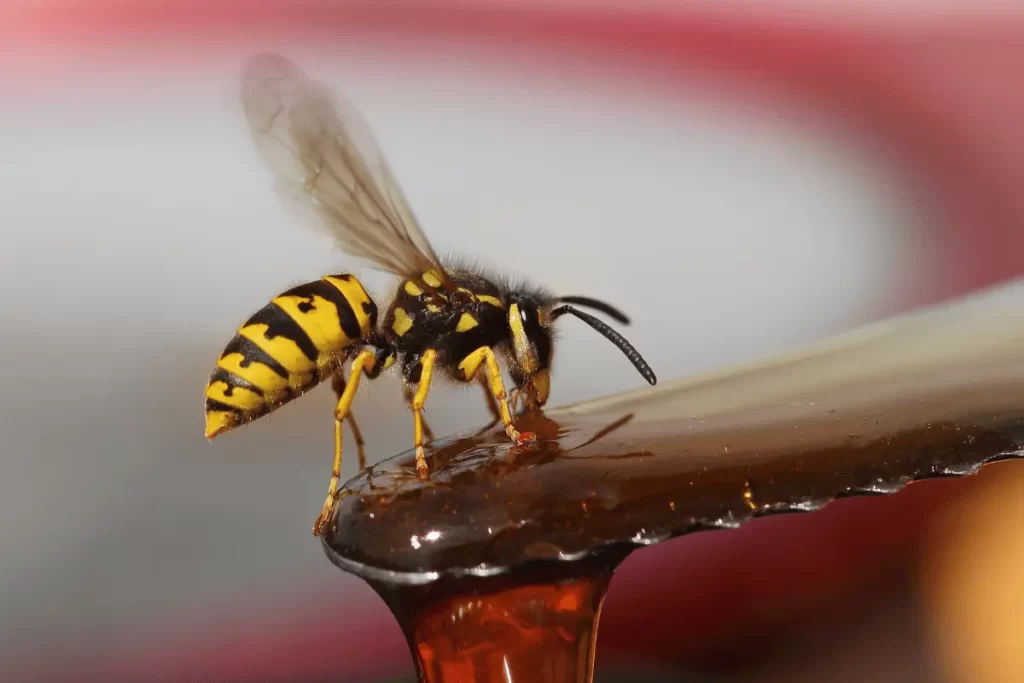
These wasps are predatory social wasps of the genus Vespula in North America. Yellow jacket females have stingers on their bodies that they can use repeatedly. Although they are not aggressive, they’ll defend their nest with sting whenever they feel a threat from you.
On average, yellow jackets can fly at speeds ranging from 6 to 7 miles per hour, considerably outpacing the speed of a human. Moreover, yellow jackets can move their wings the same as bees. Like a bee, they have two sets of wings, a larger forewing and a smaller hindwing, both of which are linked to the thorax.
Yellow jackets, on the other hand, lay their wings flat as they land, while bees fan their wings somewhat when foraging.
The Asian Giant Hornet
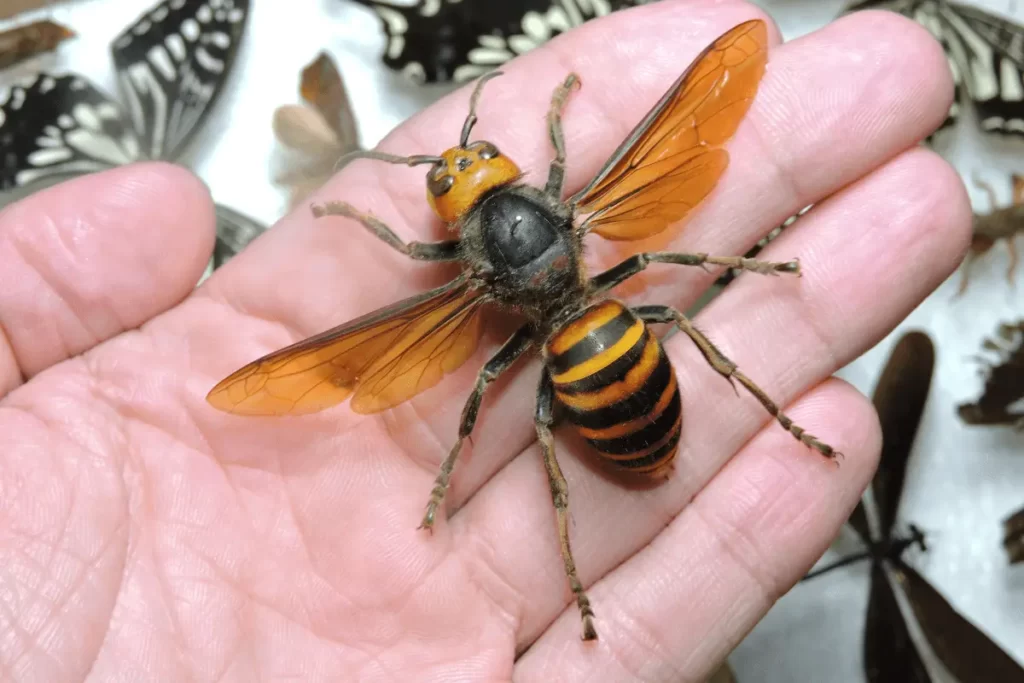
The Asian Giant hornet is the world’s largest hornet and is native to East and South Asia. It’s renowned for having a remarkable rate of flight. These hornets can reach speeds of up to 25 miles per hour (40 kilometers per hour) when flying. This speed allows them to cover large distances quickly, making them efficient hunters and foragers.
Moreover, these hornets possess two sets of wings: a longer & bigger outer set and a shorter & smaller inner set. Additionally, hornets tend to be more aggressive in the late autumn. The colony grows more guarded because this is the time when their new queen is developing. So, whenever you come across them during this period, they tend to bite or attack you.
Houseflies V/S Wasps
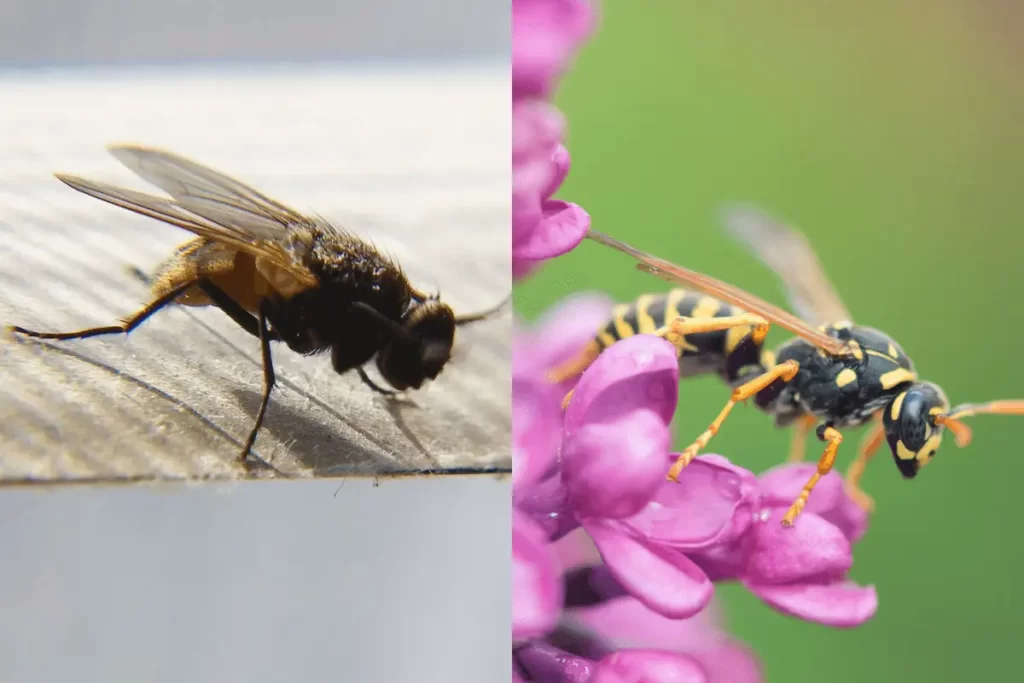
Wasps and houseflies are both insects, however, they come from different families and have different traits, habits, and ecological functions. Houseflies belong to the family Muscidae while wasps belong to various families, with some common ones being Vespidae and Apidae.
Houseflies are usually small insects with a grayish appearance and large compound eyes. They have two wings instead of a second pair of wings. On the other hand, wasps can vary widely in size, color, and appearance depending on the species. They generally have slender bodies, narrow waists, and wings.
As wasps can fly up to a speed of 25 miles per hour, houseflies are quite slow in this manner. They can fly at a top speed of 5 miles per hour, but due to their acrobatic skills, they seem to move at a quicker rate. Although their wings beat 200 times more rapidly than certain wasps’, this does not convert into speed.
Honeybees V/S Wasps
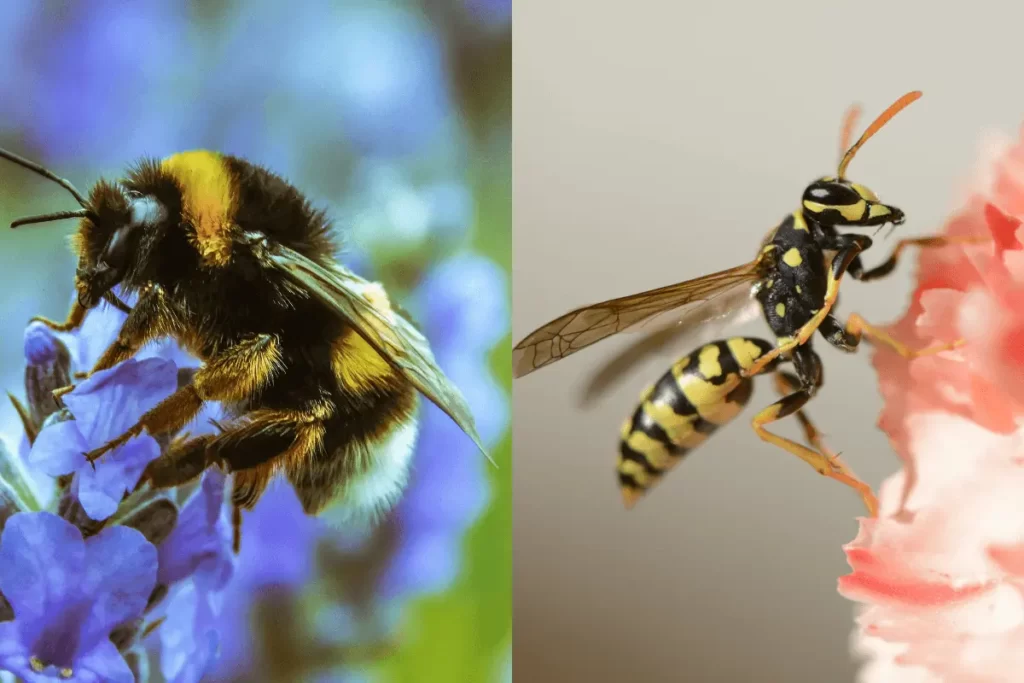
Although wasps and honeybees are two different species of insects that belong to the order Hymenoptera, they have various behavioral, ecological, and physical differences. Wasps come in various hues and frequently have black and vivid yellow patterns. They possess slim bodies with a small waist.
In comparison to wasps, honeybees are often larger and hairier. They frequently have golden or brownish-yellow stripes that are black. The typical flying speed of the honey bee is 19 MPH. While hornets or wasps are known to demolish bee colonies by collecting their larvae and pupae to feed their young, killing them is not as quick as doing so.
Additionally, wasps tend to be more hostile and possessive. They are known to have painful stings and can sting repeatedly. Contrarily, honeybees are often less aggressive and less prone to sting unless their colony is in danger.
Wasps V/S Hummingbird Moths

Hummingbird moths and wasps are both intriguing animals, although they are members of different groups and have distinctive traits. Wasps are members of the Hymenoptera order, while hummingbird moths are insects belonging to the family Sphingidae.
Paper wasps, which eat moths, find hummingbird moths to be good food. These moths have wings that beat at a rate of only 70 beats per second, which makes them seem much slower than wasps. They do, however, have a top speed of 12 mph. It implies that a wasp chasing a hummingbird moth could have trouble catching up with it.
Furthermore, most wasps are carnivorous and feed on insects, spiders, and other small animals. On the other hand, hummingbird moths are known for their specialized feeding behavior. They have a long proboscis to extract nectar from flowers while hovering in the air.
Butterflies V/S Wasps

Although both butterflies and wasps are insects, they belong to separate taxonomic groupings and have unique traits, behaviors, and ecological roles. Butterflies belong to the order Lepidoptera while wasps belong to the order Hymenoptera, which also includes ants and bees.
Butterflies often have long, thin bodies and scale-covered, vibrant wings. They look rather soft and are frequently connected to pollination. While wasps can have various body forms, however, many look more robust and lack color.
Moreover, the butterfly is one of the few insects with some of the strongest natural reflexes and can travel at speeds of up to 37 mph. Thus, a butterfly can’t outpace even the Asian giant hornet, the quickest wasp on the earth. Additionally, butterflies are significant pollinators that aid in the reproduction of numerous plant types. Wasps have an ecological role by consuming other insects, including pest species, and thereby regulating insect populations.
| Insects | Flying Speed |
| Wasp | 12 MPH |
| Honey Bee | 19 MPH |
| Butterflies | 37 MPH |
| Houseflies | 5 MPH |
| Hummingbird Moth | 12 MPH |
| Yellow Jacket | 7 MPH |
| Asian Giant Hornet | 25 MPH |
Do Wasps Hover?
Yes, wasps can hover but only a few have this capability. Many species of wasps, especially those in the family Vespidae (which includes paper wasps, yellow jackets, and hornets), can hover in place. They accomplish this by flapping their wings rapidly in a rhythm that produces enough lift to keep them hovering in the air without moving.
Their ability to hover is quite helpful, when wasps are searching for nourishment, such as nectar from flowers, or when they are looking for insects to catch. They can carefully analyze their environment and precisely target their prey while hovering. Moreover, they can fly quickly and agilely thanks to a complex system, but when they fly slowly, they are less controllable.
It’s worth noting that not all species of wasps hover in the same way or with the same frequency.
How Does a Wasp Fly?
A wasp flies through a mechanism that requires the synchronized movement of its wings and muscles. Wasps have a more streamlined body that is better suited for flying and hunting than bees, who have a specialized section of the body known as a “pollen basket.”
The wasp uses quick, figure-eight movements of its wings to fly. The wings cycle up and down during both the forward and backward strokes because of this pattern. The thoracic muscles of the wasp quickly contract and release, which causes the wings to beat at a high frequency.
Moreover, during the power stroke, the wings travel downward, pushing air downward, which raises the pressure beneath the wings. The wasp can maintain flight thanks to the pressure differential’s lift. Wasps may modify the frequency and amplitude of their wing beats to alter their flying. Their wings may move in different directions by altering their angle and location.
Additionally, wasps use their antennae and other sensory organs to help them stay stable when flying. These sensors offer data on their direction, speed, and immediate surroundings. The wasp uses this knowledge to make necessary modifications for a steady flight path.
Do Wasps Fly Backward?
Yes, wasps can fly backward. Although similar to other flying insects, wasps move forward or hover stationary during their flight, they are known to use their ability to fly backward to orient themselves so they can remember how to get back to their nests. They will also fly backward as they go between blooms to get nectar.
Wasps do reconnaissance flights to become familiar with the surroundings before they leave a nest to ensure they know how to return to it. Before continuing, this entails making a few quick loops around the nest.
According to the Journal of Current Biology, wasps can fly backward to view the nest from the perspective of an approaching visitor. The wasps fly backward in orderly patterns as they gradually depart from the nest higher and farther. Additionally, they can save this information and utilize it to locate the nest later.
Are Wasps’ Wings Just Used for Flight?
No, wasps do not only use their wings for flight. Wasps’ wings have different uses besides just being used for flight. To name a few:
- Wasps can communicate by making sounds with their wings. They can communicate with other hummingbirds in their colony by making a variety of wing vibrations and sounds.
- They can regulate their body temperature by moving their wings. For this, they flap their wings rapidly to generate heat or increase air circulation around their bodies, helping them control their temperature in varying environmental conditions.
- Moreover, wasps may utilize their wings to signal and communicate with one another during courtship and mating rituals. These wing motions may help birds find partners and organize the mating process.
- Besides that, when necessary, wasps may defend themselves using their wings. In times of danger, they may spread their wings widely to appear larger and more intimidating to potential predators.
What Causes Wasps to Chase You?
Wasps may chase you for several reasons, but their key motivations are instinctive behaviors and environmental circumstances. They may chase you for the following reasons:
- When you approach their nests or feeding places, wasps may see them as dangerous since they are territorial insects. Therefore, they might run after you.
- Wasps are drawn to items high in sugar or protein, such as sweet drinks or meat when you’re eating or drinking outside. They may pursue you to get these resources.
- Rapid or sudden movements can trigger a wasp’s natural defensive response. If you swat at a wasp or make quick motions around them, they might interpret it as aggression and respond by chasing you.
- Further, strong scents, such as perfumes, lotions, or even scented soaps, can attract wasps. They might be drawn to these scents and follow you in search of the source.
It’s crucial to keep in mind that not all wasps will chase you, and not all wasp encounters will result in being pursued.
How Far Does a Wasp Chase You?
The kind of wasp, the degree of threat it senses, and its behavioral habits can all affect how far a wasp will chase you. Wasps typically guard their nests and might turn hostile if they feel threatened.
Some species of wasps are known to be more aggressive and persistent in their pursuit. For example, yellow jackets and hornets are often more aggressive than paper wasps and might chase you for a longer distance if they perceive you as a threat.
The majority of the time, a wasp would only pursue you for a short distance—usually 20–30 feet (6–9 meters)—before giving up. The wasp may, however, follow you for a greater distance if it feels very threatened or irritated. Keep in mind that individual wasp behavior can vary, so there’s no strict rule about how far a wasp will chase you.
How Long Are Wasps Able to Fly?
The length of a wasp’s flight might vary based on the species, the habitat, and the wasp’s general health. Adult wasps can often fly for a long period, typically between a few minutes and several hours.
Social wasps, such as paper and yellow jacket wasps, are well recognized for being energetic fliers and can fly for long periods while searching for food, protecting their nests, or simply scouting their environment. They can fly effectively and with strength. Wasps, like many insects, have a brief lifespan that is frequently measured in weeks or months. As a result, their lifetime flying time may not add up to very long periods.
Additionally, some solitary wasp species, which often have more specific behaviors like hunting and provisioning for their offspring, might not fly as frequently or for as long durations as social wasps.
How Quickly Do Wasp Wings Vibrate?
Wasps’ wings vibrate at different frequencies based on their species, size, and activity, like many other insects. On average, the wings of most wasp species vibrate at frequencies ranging from around 117 to 250 Hz (hertz), which means they flap their wings about 117 to 250 times per second.
These swift wing movements enable them to produce the lift required for flight and maneuverability. However, it’s crucial to remember that the wingbeat frequencies of various wasp species might vary slightly. For instance, somewhat lower frequencies may be present in larger wasps, whilst higher frequencies may be present in smaller species.
Can You Run Away From A Wasp?
Yes, you can run away from a wasp, and it’s a natural reaction for many people when they feel threatened by a wasp or any other stinging insect. However, running away might not always be the best approach, as sudden movements and increased activity can sometimes provoke the wasp and make it more likely to sting.
Take into account the following advice if you happen to be among wasps and wish to prevent getting stung:
- Stay calm because sudden movements and panic can attract the attention of the wasp and make it more likely to perceive you as a threat.
- If you want to leave the area, do so slowly and calmly. Quick movements might make the wasp agitated.
- A wasp can see your swatting at it as aggressive behavior, in which case it might hurt you.
- If a wasp becomes hostile and begins to hover around you, you can use clothing or an object (such as a cap or bag) to establish a barrier between yourself and the wasp.
- What’s more, if a wasp lands on you, stay still. Often, wasps are exploring their surroundings and might leave if they don’t perceive you as a threat.
What Temperature Causes Wasps to Quit Flying?
Being ectothermic wasps’ internal body temperatures are affected by the outside temperature. In general, wasps become less active or sluggish when temperatures drop and are more energetic in warmer weather. The wasps don’t cease flying or going about their business at the same temperature, either.
Moreover, the behavior of wasps in response to temperature can vary based on several factors, including the species of wasps, the local climate, and the specific conditions of the environment. Some wasps may become less active at lower temperatures, while others might be more cold-tolerant and remain active at cooler temperatures.
Additionally, due to their difficulty in maintaining their metabolic processes at lower temperatures, wasps may become less active or even immobilized in colder climates. That’s why, they are less active in winter.
Bottom Line
Wasps are one of the most prevalent household insects. They are not the world’s fastest insects, but they are capable of moving quickly. Wasps are calm insects except for yellow jackets. The flying speed of wasps varies depending on the type of species and circumstances.
On average a wasp can fly up to 20 MPH and can lead to 25 MPH too. Additionally, individual wasps may not maintain high speeds for extended periods and might alternate between different flight speeds based on their activities.
Above all, if you ever see wasps wandering in your yard or home, try to avoid them, don’t swat, and move slowly to prevent yourself from an attack or being stung.
FAQs
References
Zi-Long Zhao, Hong-Ping Zhao, Guo-Jun Ma, Cheng-Wei Wu, Kai Yang, Xi-Qiao Feng; Structures, properties, and functions of the stings of honey bees and paper wasps: a comparative study. Biol Open 15 July 2015; 4 (7): 921–928. doi: https://doi.org/10.1242/bio.012195
Stürzl, Wolfgang et al. Current Biology, Volume 26, Issue 4, 470 – 482
